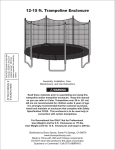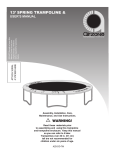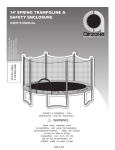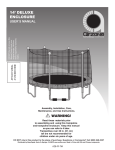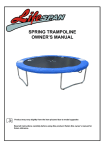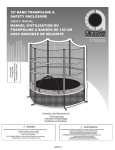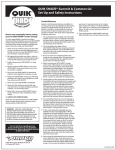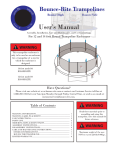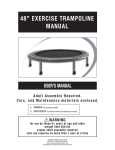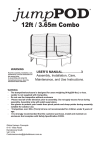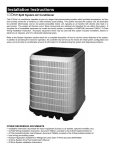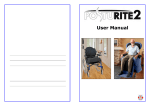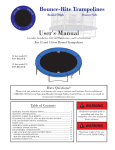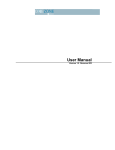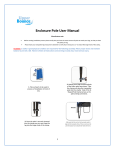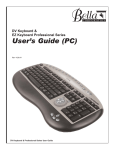Download 8` Spring Trampoline with Enclosure User Manual
Transcript
ATTACH SERIAL # STICKER HERE DO NOT discard or lose this manual, serial #, and your original receipt. All three items required for warranty claims 12-15 ft. Spring Trampoline Assembly, Installation, Care, Maintenance, and Use Instructions WARNING Read these materials prior to assembling and using this trampoline and/or trampoline enclosure. Keep this manual so you can refer to it later. Trampolines over 20 in. (51 cm) tall are not recommended for children under 6 years of age. It is strongly recommended that the customer purchase, install and maintain an enclosure that complies with Safety Specification F2225. This enclosure is to be used only in connection with certain trampolines. For Recreational Use ONLY. Not for Professional Use. User Weight Limit for 8 ft. Trampolines is 175 lbs. User Weight Limit for 12 ft. Trampolines is 200 lbs. User Weight Limit for 13 ft. Trampolines and larger is 250 lbs. (Do Not exceed the user weight limit of an Enclosure if used) Distributed by Bravo Sports, Santa Fe Springs, CA 90670 www.bravosportscorp.com. Made in China with USA and Chinese components. DO NOT return this product to the place of purchase. Questions or Comments? Call (877)-99BRAVO. WARNING Read these materials prior to assembling and using this Trampoline Table of Contents 1 - Liability 1 - Initial Warning 2 - Assembly and Installation Instructions 2 - Care and Maintenance Instructions 3 - Use Instructions 4 - Trampoline Safety and Accident Prevention 4 - Owner’s and Supervisor”s Role in Preventing Injuries & Responsibilities 4 - User’s Role in Preventing Injuries and Responsibilities 5-6 - Fundamental Bounces 7 - Frame Assembly 8 - Mat and Cover Assembly 9 - Limited Warranty Liability While every attempt is made to embody the highest degree of protection in all equipment, we cannot guarantee freedom from injury. The user assumes all risk of injury due to use. All merchandise is sold on this condition, which no representative of the company can waive or change. WARNING In addition to the instructions and precautions provided with your trampoline and/or enclosure, the following precautions must be observed.In addition to the instructions and precautions provided with your trampoline and/or enclosure, the following precautions must be observed. • DO NOT attempt or allow somersaults on the trampoline. Landing on the head or neck can cause serious injury, paralysis, or death, even when landing in the middle of the bed. (7.4.2.1) • Do not allow more than one person inside the trampoline enclosure. Use by more than one person at the same time can result in serious injury. (7.4.2.2) • Use trampoline and trampoline enclosure only with mature, knowledgeable supervision. (7.4.2.3) • Adequate overhead clearance is essential. A minimum of 24 ft from ground level is recommended. Provide clearance for wires, tree limbs, and other possible hazards. (7.2.3.1) • Lateral clearance is essential. Place the trampoline and trampoline enclosure away from walls, structures, fences, and other play areas. Maintain a clear space on all sides of the trampoline and trampoline enclosure. (7.2.3.2) • Place the trampoline and trampoline enclosure on a level surface before use. (7.2.3.3) • Use the trampoline and trampoline enclosure in a well-lighted area. Artificial illumination may be required for indoor or shady areas. (7.2.3.4) • Secure the trampoline and trampoline enclosure against unauthorized and unsupervised use. (7.2.3.5) • Remove any obstructions from beneath the trampoline and trampoline enclosure. (7.2.3.6) • The trampoline enclosure is only to be used as an enclosure for a trampoline of a size for which the enclosure is designed. (7.2.3.7) For Recreational Use ONLY. Not for Professional Use. User Weight Limit for 8 ft. Trampolines is 175 lbs. User Weight Limit for 12 ft. Trampolines is 200 lbs. User Weight Limit for 13 ft. Trampolines and larger is 250 lbs. (Do Not exceed the user weight limit of an Enclosure if used) 1 WARNING Assembly and Installation Instructions • Adequate overhead clearance is essential. A minimum of 24 ft from ground level is recommended. Provide clearance for wires, tree limbs, and other possible hazards. (7.2.3.1) (7.2.4.1) • Lateral clearance is essential. Place the trampoline and trampoline enclosure away from walls, structures, fences, and other play areas. Maintain a clear space on all sides of the trampoline and trampoline enclosure. (7.2.3.2) (7.2.4.2) • Place the trampoline and trampoline enclosure on a level surface before use. (7.2.3.3) (7.2.4.3) • Use the trampoline and trampoline enclosure in a well-lighted area. Artificial illumination may be required for indoor or shady areas. (7.2.3.4) (7.2.4.4) • Secure the trampoline and trampoline enclosure against unauthorized and unsupervised use. (7.2.3.5) (7.2.4.5) • Remove any obstructions from beneath the trampoline and trampoline enclosure. (7.2.3.6) (7.2.4.6) • The trampoline enclosure is only to be used as an enclosure for a trampoline of a size for which the enclosure is designed. (7.2.3.7) • The owner and supervisors of the trampoline are responsible to make all users aware of practices specified in the use instructions. (7.2.4.7) For safe use it is very important that the frame padding be securely attached to the frame and in the correct position prior to using the trampoline. Please refer to diagram mat cover (7.2.2) - Please make sure cover is positioned correctly to completely covers top rail, springs (or bands), and mat edge. tie strap with a loop to allow for mat movement tie straps tightly around top rail top rail WARNING Care and Maintenance Instructions Inspect the trampoline and trampoline enclosure before each use and replace any worn, defective, or missing parts. The following conditions could represent potential hazards: 1. Missing, improperly positioned, or insecurely attached frame padding. 2. Punctures, frays, tears, or holes worn in the bed or frame padding. 3. Deterioration in the stitching or fabric of the bed or frame padding. 4. Ruptured springs or ruptured bands. 5. A bent or broken frame. 6. A sagging bed. 7. Sharp protrusions on the frame or suspension system. (7.3.2.1) The trampoline and/or enclosure is NOT to be left outside in rain, snow, or windy conditions. If such conditions occur please disassemble your trampoline and/or enclosure and store for future use in mild weather conditions. 2 WARNING Use Instructions • DO NOT attempt or allow somersaults on the trampoline. Landing on the head or neck can cause serious injury, paralysis, or death, even when landing in the middle of the bed. (7.5.1.1) • Do not allow more than one person on the trampoline. Use by more than one person at the same time can result in serious injuries. (7.5.1.2) • Use trampoline and trampoline enclosure only with mature, knowledgeable supervision. (7.5.1.3) • Trampolines over 20 in. (51 cm) tall are not recommended for use by children under 6 years of age. (7.5.1.4) • Inspect the trampoline before each use. Make sure the frame padding is correctly and securely positioned. Replace any worn, defective, or missing parts. (7.5.1.5) • Climb on and off the trampoline. It is a dangerous practice to jump from the trampoline to the floor or ground when dismounting, or to jump onto the trampoline when mounting. Do not use the trampoline as a springboard to other objects. (7.5.1.6) • Stop bounce by flexing knees as feet come in contact with the trampoline bed. Learn this skill before attempting others. (7.5.1.7) • Learn fundamental bounces and body positions thoroughly before trying more advanced skills. A variety of trampoline activities can be carried out by performing the basic fundamentals in various series and combinations, performing one fundamental after another, with or without feet bounces between them. (7.5.1.8) • Avoid bouncing too high. Stay low until bounce control and repeated landing in the center of the trampoline can be accomplished. Control is more important than height. (7.5.1.9) • While keeping the head erect, focus eyes on the trampoline toward the perimeter. This will help control bounce. (7.5.1.10) • Avoid bouncing when tired. Keep turns short. (7.5.1.11) • Properly secure the trampoline when not in use. Protect it against unauthorized use. If a trampoline ladder is used, the supervisor should remove it from the trampoline when leaving the area to prevent unsupervised access by children under 6 years of age. (7.5.1.12) • Keep objects away which could interfere with the performer. Maintain a clear area around the trampoline. (7.5.1.13) • Do not use the trampoline while under the influence of alcohol or drugs. (7.5.1.14) • For additional information concerning the trampoline equipment, contact the manufacturer. (7.5.1.15) • For information concerning skill training, contact a certified trampoline instructor. (7.5.1.16) • Bounce only when the surface of the bed is dry. Wind or air movement should be calm to gentle. The trampoline must not be used in gusty or severe winds. (7.5.1.17) • Read all instructions before using the trampoline. Warnings and instructions for the care, maintenance, and use of this trampoline are included to promote safe, enjoyable use of this equipment. (7.5.1.18) 3 Trampoline Safety and Accident Prevention As in most recreational sports, participants may be injured. This section covers the most common accidents. Responsibilities of the supervisors and jumpers in accident prevention are also outlined. The following are reasons why accidents happen: Attempting somersaults. Landing on the head or neck can cause serious injury, paralysis, or death, even when landing in the middle of the bed. More than one person on the trampoline. Use by more than one person at the same time can result in serious injuries. Incorrect mounting and dismounting. Carefully crawl out of and into the trampoline bed. Do not jump off to the ground. Do not jump from a roof, or other object onto the trampoline. Small children may need assistance to get on or off the trampoline. Do not step onto the suspension system. Hitting the frame. Stay in the center of the trampoline when jumping. Injury may result from hitting the frame when control is lost. Be sure the frame cover is always on and the pads securely fastened. Do not jump directly onto the frame pad. Loss of control. A jumper who loses control will increase his/her chance of injury. Be sure to familiarize yourself with the basic jumps before doing more difficult ones. Jumps should be mastered, performed repeatedly before moving on to the next level. To regain control and stop your jump, bend your knees sharply as you land. Alcohol and drug use. Because alcohol and drug use impairs the jumpers' coordination, loss of control as well as injuries are greatly increased. Foreign objects. Please make sure there is nothing sharp under and around the trampoline. Hitting objects under the trampoline can cause injury. Jumping with a foreign object can also increase the chances of getting injured. Be sure there is adequate clearance 24 ft. above and 10 ft. around the trampoline. Be careful of overhead wires, tree limbs etc. Bad weather. Do not use your trampoline in gusty winds or inclement weather. The bed should not be wet. Poor maintenance of the trampoline. Make sure you inspect the trampoline before every use. Check for punctures on the bed, sharp burrs on the frame, stitching that has gone bad or loose elastic bands. If a replacement part is needed, please call our hotline to order. Unlimited access. The trampoline should be covered or dis-assembled when not in use.This will prevent unsupervised small children from using the trampoline. Owner’s and Supervisor’s Role in Preventing Injuries & Responsibilities The jumper must first learn all of the basic, fundamental bounces before attempting more difficult ones. Low, controlled bounces are a good start before learning the basic landing positions and combinations. Jumpers need to understand that control is key to a successful jump. Review of the users' manual to learn basic techniques is a must. Following the tips in the placard is also important. Contact a certified trampoline instructor for more information. User’s Role in Preventing Injuries & Responsibilities The supervisor's role is to make sure the users know all the safety rules as well as learn the basic, fundamental bounces. They need to enforce all the safety rules and warnings in the manual, frame and labels. When a supervisor is not available, the trampoline may be dis-assembled or covered to limit access. It is the supervisor's responsibility that the placard with the Trampoline Safety Tips is placed where all jumpers are informed about the tips. 4 FUNDAMENTAL BOUNCES STANDING BOUNCE KNEE BOUNCE 1. First, assume kneeling position in center of bed, back straight , eyes on end of bed. 2. Pump your way to your feet by bouncing, using your arms as in standing bounce. 1. Start in the center of bed, feet shoulderwidth apart, arms at side, eyes on end of bed. 3. Duplicate position from a low bounce 2. As you jump from trampoline, arms come up and forward, circling outward and back to side as you again contact bed. Bring feet together, toes pointed, in the air, feet shoulders-width apart again as you contact bed. Arms need never go above your shoulders or behind your body. HANDS AND KNEE DROP FRONT DROP 1. First, assume position shown in illustration, keeping head up, eyes on end of bed. 2. Duplicate position from a low bounce. Keep your hands as close to your knees as shown in illustration. 1. First, assume position of hands and knees bounce. Begin to bounce slightly in this position, then kick legs back, land on stomach, taking some weight on bent forearms as shown in illustration. Make sure you kick backwards, do not go forward , and return to hands and knees position. SEAT DROP 2. Try from a low bounce, kicking backward s , making your belt land where your feet were. 1. First, assume sitting position in center of bed, legs spread wide, hands on bed, leaning slightly forward. 2. Duplicate this position from a low bounce. To come to your feet again, be sure to lea n forward and press bed with your hands. 5 FUNDAMENTAL BOUNCES BACK DROP PIROUETTE 1. Lie on your back on bed, spread your legs slightly and raise them about 45 degrees from the surface of the bed, raise your arms to corresponding angle, raise head and look at end of trampoline. This is your landing position. HALF PIROUETTE: Done like a standing bounce, but at top of bounce , swiftly turn head and search for opposite end of trampoline. Do not travel. Land on feet. 2. Try cautiously from a low bounce, making sure you do not lose sight of end bar of trampoline at any time. Weight should be taken more on your shoulders than on your hips. FUL L PIROUETTE: Done as above, but continue around, until a complete circle has been made. Spot by looking for end bars as you complete trick. TUCK POSITION PIKE POSITION Done like a standing bounce, but at top of bounce , bring knees to chest and grasp with arms. Then lower feet to contact bed. Done like a standing bounce, but at top of bounc e , keeping knees locked and toes pointed, raise legs as illustrated, then lower feet to contact bed. LAYOUT POSITION STRADDLE POSITION Done like pike bounce, but with legs spread as widely as is comfortable. Reach for your toes! Done like a standing bounce, but at top of bounce , stretch slightly, arching back, and momentarily looking skyward. 6 SPRING TRAMPOLINE ASSEMBLY- Frame (2-PC JOINT) Refer to parts list for identification of parts. WARNING: Three adults in good physical condition are required for the following assembly. Wear proper shoes and maintain balance to prevent a fall. Failure to follow all instructions and warnings exactly may result in serious injury. Rail Screws 1- Begin by assembling one of the 6 “W” shaped legs. Attach one of the leg extensions (E-with 2 holes) to the left and onel eg extension (F-with 4 holes) to the right. Align holes and secure together with small screws. Continue until all legs are assembled. 4- Insert and tighten the bolt to hold the four pieces together. 2- To assemble the top rail, connect two rails until the bolt holes line up. 3- Position the socket elements as shown. Note the larger hole (bottom part) should be facing outwards. 5- Continue until you form a large circle. Joining the last link may require three adults in good physical condition. With one person holding the opposite end, bring both sides of the circle firmly together. 6- Attach the leg assemblies into the sockets, secure all [12] leg extensions in the t-joints using the screws. 7- Attach the leg assemblies making sure the uprights alternate (E, F, E, F...). Note- E is the upright with no holes on the sides, whereas F has two holes. 7 TRAMPOLINE MAT AND COVER ASSEMBLY Refer to parts list for identification of parts. WARNING: Please use extreme caution not to pinch or trap your fingers when assembling the springs. Please use the spring tool provided to attach springs under tension. 10- Repeat this step directly across from where you attached the first spring. You will have to count to make sure the correct ring is the same number of slots away from the starting point. 8- With stitching portion facing downward, lay jump mat inside frame and attach a spring into a ring on the mat. 9- Attach spring with ring into frame. 11- Attach two more springs half the distance between the first two. Count to make sure rings and slots are aligned. 12- As you add springs the tension will increase. Use the spring tool to safely hook the ends into the rail as shown. 13- Repeat the process of placing the springs half the distance among the already placed springs. To even out tension, attach a spring opposite the one just attached. 15- Lay padded cover on outer edge to cover springs. The outer edge should cover the top rail as shown. 16- Tie all the outer black straps tightly to the top rail so it’s completely covered. Tie all the inner black straps loosely to the rings on the mat. These inner straps need slack to move as the mat bounces. Do not tie strap to the springs. 14- Attach remaining springs until all springs are placed on frame. Warning: Trampoline is under tension and effort may be required to attach springs to frame. Be careful not to pinch fingers or slip. Serious injury may occur! 17- The trampoline is now complete. Test with a few light bounces and make sure everything is remaining secure for normal use. 8 LIMITED WARRANTY DO NOT RETURN TO PLACE OF PURCHASE Subject to the following limitations, in addition to any imposed by virtue of applicable law, Bravo Sports warrants this Variflex, UltraFlex or AirZone trampoline and/or safety enclosure to be free from defects in materials and workmanship under normal use and service conditions. The tubular steel frame is warranted for two (2) years after the date of purchase. All other parts are warranted for ninety (90) days after the date of purchase. This warranty is limited to the repair and/or replacement of defective parts only. All requests for missing parts must be pre-authorized by calling customer service within 30 days of the date of purchase and must be accompanied by an original receipt from an authorized dealer. Certain regions of the country have environmental conditions that are extremely hard on trampolines or enclosures of any kind. If you live in Arizona, Florida, Nevada, New Mexico, Texas, or in high altitudes (above 3000 feet), the warranty period for your item will be limited to six months from the date of original purchase. (After expiration of that six month period and up to a period of one year following date of original purchase, you may purchase a replacement canopy top at a reduced price from our customer services department.) 1. This Limited Warranty will apply only if the part(s) are returned freight pre-paid to the Customer Service Department listed below and are accompanied by both an original receipt from an authorized dealer and the Serial Number found on the frame or instruction manual, and if Bravo Sports, at its sole discretion, determines it (them) to be defective. 2. This Limited Warranty will apply only to Variflex, UltraFlex or AirZone trampolines and/or enclosures that are purchased from an authorized dealer. This Limited Warranty is extended only to the original consumer purchaser and is not transferable. 3. Be sure to retain your original purchase sales receipt and instruction manual for any warranty claim. The instruction manual has a Serial Number on the front cover (a duplicate of which is also found on one of the tubular steel components) that is required for all missing parts and warranty claims. All warranty claims must be accompanied by the original purchase receipt from an authorized dealer and this serial number. 4. Before returning any parts to Bravo Sports for warranty inspection, the original consumer purchaser must obtain an RMA Number (Return Merchandise Authorization number) from Bravo Sports. Such authorization can be obtained by calling our Customer Service Dept. at the toll-free number listed below or by writing to the Bravo Sports Customer Service Department at the address listed below. The original consumer purchaser is responsible for all shipping costs. 5. Upon receipt of authorization from our Customer Service Department, you must submit your warranty claim to the address below, ship parts freight pre-paid, accompanied by the original, and dated purchase receipt with the Serial Number from the manual or frame written on it. Do not return this product to the place of purchase. For warranty service, or for missing or replacement parts or any other problems, call or write to our Customer Service Department at the phone number or address listed below. We will send any replacement parts via FedEx Ground. 6. This Limited Warranty does not cover damage or loss from: wind, rain, fire, snow, ice, or other forces of nature; accident; normal wear ; improper assembly, disassembly, or adjustment during set-up or take-down; or any abuse, neglect or misuse of this trampoline, enclosure and/or its parts. Any alteration to the original product voids this warranty. 7. To the extent allowed by applicable law, any implied warranty of merchantability or fitness applicable to this Variflex / AirZone Trampoline and/or Enclosure is limited to the duration of this Limited Warranty. Bravo Sports does not warrant against, and in no event shall Bravo Sports or its authorized agents be liable for, any personal loss , injury, or direct or indirect incidental or consequential damage resulting from the use of this product. Please note that some states do not allow the exclusion or limitation of incidental or consequential damages, so the above limitation or exclusion may not apply to you. This Limited Warranty gives you specific legal rights and you may have other rights which vary from state to state. Do not allow more than one person on the trampoline or inside the trampoline enclosure. Use by more than one person at the same time can result in serious injury and will void the warranty. This Limited Warranty is null and void if the “Care and Maintenance” instructions on page 2 and the “Use Instructions” on page 3 of this Manual are not followed prior to each use of the trampoline. 9










